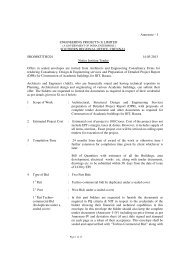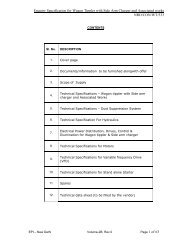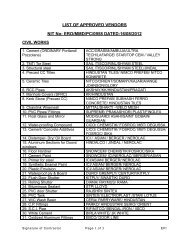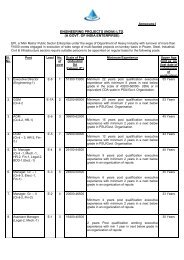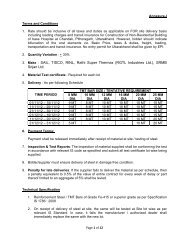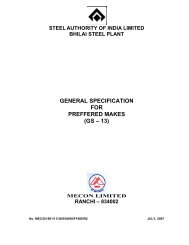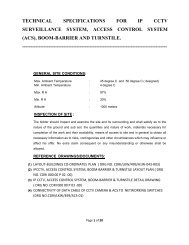SAIL General Technical Specification - Engineering Projects India Ltd.
SAIL General Technical Specification - Engineering Projects India Ltd.
SAIL General Technical Specification - Engineering Projects India Ltd.
Create successful ePaper yourself
Turn your PDF publications into a flip-book with our unique Google optimized e-Paper software.
© 2007 MECON Limited<br />
All rights reserved<br />
<strong>General</strong> <strong>Technical</strong> <strong>Specification</strong><br />
5.6 Stone (granite, trap, sandstone, quartzite etc.)<br />
5.6.1 Stone used shall be strong, durable, dense, compact, close grained, homogeneous, fire<br />
resistant and shall be obtained from sources approved by Engineer. Stones shall<br />
additionally be hard, sound, free from cracks, decay and other flaws or weathering and<br />
shall be easily workable. Stones with round surfaces shall not be made use of.<br />
5.6.2 Stones shall have a crushing strength of not less than 200 kg/cm2. Stones with lesser<br />
crushing strength may be used in works with prior approval of the Engineer. Stones shall<br />
be non-porous and when tested in accordance with IS : 1124 -1974 "Method of Test for<br />
Determination of Water Absorption Etc.," shall show water absorption of less than 5% of its<br />
dry weight when soaked in water for 24 hours. Tests for durability and wheathering shall be<br />
done in accordance with IS : 1126-1974 and IS : 1125-1974 respectively. The working of<br />
stones to required sizes and their dressing shall be as per IS : 1127-1970<br />
"Recommendations for dimensions and workmanship of natural building stones for<br />
masonry work" and IS : 1129 -1972 "Dressing of Natural Building Stones". Stones<br />
especially limestone and sand stones shall be well seasoned by exposure to air before use<br />
in construction works.<br />
5.6.3 Size<br />
5.6.4 Dressing<br />
Normally stones shall be of size that could be lifted and placed by hand, between 20 to 30<br />
kg per piece. The length of stones shall not exceed 3 times the height and the breadth on<br />
base shall not be greater than 3/4 of the thickness of wall or less than 15cm. The height of<br />
stone may be upto 30cm.<br />
5.6.4.1 Random rubble<br />
Stones shall be hammer dressed on the face, the sides, and the beds to enable it to come<br />
into close proximity with the neighbouring stone. The bushings in the face shall not project<br />
more than 4cm on all exposed faces and 2cm on a face to be plastered, nor shall it have<br />
depressions more than 1cm from the average wall surface.<br />
5.6.4.2 Coursed rubble - First sort<br />
Face stones shall be hammer dressed on all beds, and joints, so as to give them<br />
approximately rectangular block shape. These shall be squared on all joints and beds. The<br />
bed joint shall be rough chisel dressed for atleast 5cm back from the face, and side joints<br />
for atleast 4cm such that no portion of the dressed surface is more than 6mm from a<br />
straight edge placed on it. The bushing on the face shall not project more than 4cm as an<br />
exposed face and one cm on a face to be plastered. The hammer dressed stone shall also<br />
have a rough tooling for a minimum width of 2.5cm along the four edges of the face of the<br />
stone, when stone work is exposed.<br />
5.6.4.3 Coursed rubble - Second sort<br />
Dressing shall be as specified in 5.6.4.2 except that no portion of dressed surface shall<br />
exceed 10mm from a straight edge placed on it as against 6mm for first sort.<br />
5.6.4.4 Stone for veneering<br />
Stone lining upto 8cm shall be treated as veneering work. The stone shall be cut into slabs<br />
or required thickness along the planes parallel to the natural bed. Every stone shall be cut<br />
to the required size and shape so as to be free from any waviness and to give truly vertical<br />
and horizontal joints. Adjoining faces shall be fine chisel dressed to a depth of a 6mm, so<br />
that when checked with a 60cm straight edge, no point varies from it by more than 1mm.<br />
Civil<br />
Page 10 of 42<br />
GS-07




